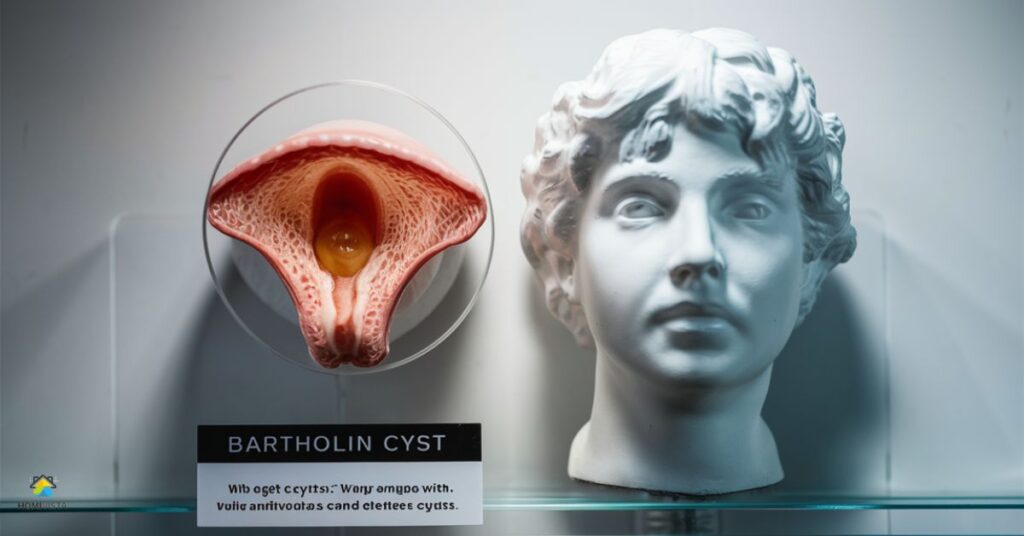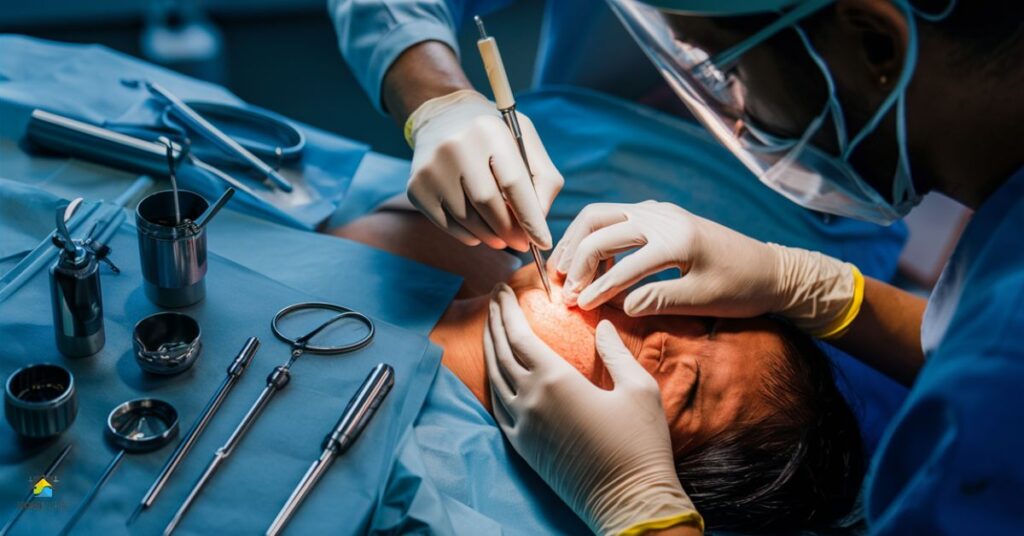Bartholin cysts can be uncomfortable. However, before attempting to burst one at home, consider consulting a healthcare professional. If you decide to proceed, use warm compresses to reduce swelling and gentle pressure to encourage drainage. Monitor for signs of infection and seek medical attention if necessary.
What is a Bartholin cyst?
A Bartholin cyst forms when a duct in the Bartholin gland becomes blocked, leading to fluid buildup. These cysts can cause pain and discomfort, often requiring medical attention. Understanding their causes and symptoms is crucial for proper diagnosis and treatment.
What does a Bartholin cyst look like?
Bartholin cysts appear as small, painless lumps near the vaginal opening. They may vary in size and typically have a smooth, rounded shape. Monitoring for changes in size, color, or discomfort is important for identifying and managing these cysts.
Who gets Bartholin cysts?

- Bartholin cysts can develop in women of all ages.
- Women who are sexually active are more prone to these cysts.
- Hormonal changes can contribute to their formation.
- Poor genital hygiene can increase the risk.
- Certain infections, like sexually transmitted infections, can also be a factor.
- Women with a history of Bartholin cysts are more likely to experience recurrence.
- Conditions that affect the Bartholin glands, such as inflammation, can lead to cysts.
- Women going through menopause may experience changes in gland function, increasing the risk.
- Rarely, Bartholin cysts can occur in girls before puberty.
- Overall, anyone with a Bartholin gland can potentially develop a cyst.
Bartholin’s Cyst Symptoms
Bartholin’s cyst symptoms typically include a painless lump near the vaginal opening, which may grow larger over time. There can be discomfort while walking, sitting or during sexual activity. Some individuals may experience pain or tenderness in the cyst area. Infection-related symptoms such as redness, swelling, and pus drainage can occur, accompanied by fever or chills. Monitoring for these signs and seeking medical evaluation is essential for proper diagnosis and treatment.
Bartholin’s Cyst Causes
Bartholin’s cysts are caused by blockage of the ducts that normally drain fluid from Bartholin’s glands. Factors like hormonal changes, poor genital hygiene and infections contribute to duct blockage. Sexually transmitted infections, trauma, or inflammation of the gland can also lead to cyst formation. Changes in gland function due to age or hormonal fluctuations are additional factors. Understanding these causes helps in managing and preventing Bartholin’s cysts effectively.
Diagnosis
Diagnosis of Bartholin’s cysts involves:
Physical examination: A healthcare provider examines the genital area to check for lumps or swelling near the vaginal opening.
Medical history: Information about symptoms, medical conditions and previous occurrences of Bartholin’s cysts is gathered.
Imaging tests: Ultrasound or MRI scans may be performed to visualize the cyst’s size and location.
Lab tests: Fluid from the cyst may be tested for infection or to rule out other conditions.
Differential diagnosis: Distinguishing between a Bartholin’s cyst, abscess or other genital masses is crucial for proper treatment planning.
Treating an abscess

Warm compresses: Applying warm compresses several times a day can help reduce pain and promote drainage.
Incision and drainage (I&D): A healthcare provider may make a small incision to drain the pus from the abscess.
Antibiotics: If there’s an infection, antibiotics may be prescribed to clear the infection and prevent recurrence.
Word catheter: In some cases, a word catheter is inserted into the abscess cavity to keep it open and allow continued drainage.
Pain management: Over-the-counter pain relievers or prescribed medications can help manage pain and discomfort during recovery.
Read this blog: How Do Maggots Appear: Unveiling The Mysteries Of Maggot Infestation – Trash Rite
Management and Treatment
Bartholin’s cysts can be managed effectively through various treatments and symptom management strategies.
What are the treatments for a Bartholin cyst?
Warm Compresses: Applying warm compresses can ease discomfort and promote drainage.
Sitz Baths: Sitting in warm water can also help reduce symptoms and aid healing.
Incision and Drainage: A healthcare provider may drain the cyst if necessary.
Marsupialization: Surgical procedure to create a permanent drainage opening.
Antibiotics: If infected, antibiotics may be prescribed.
How do I manage the symptoms of a Bartholin cyst?

Pain Management: Over-the-counter pain relievers can help alleviate pain.
Comfort Measures: Wearing loose clothing and avoiding strenuous activities can ease discomfort.
Hygiene: Maintain good genital hygiene to prevent infections.
Do Bartholin cysts go away on their own?
Small, asymptomatic cysts may resolve without treatment but should be monitored for changes.
How long does a Bartholin cyst last?
The duration varies. Some may resolve within a few days to weeks, while others may persist and require medical intervention.
What comes out of a Bartholin cyst when it opens?
When a Bartholin cyst opens or is drained, it may release pus, fluid or a combination.
Should I pop a Bartholin cyst?
It’s not recommended to pop or attempt self-drainage. Consult a healthcare provider for proper
evaluation and treatment.
At-Home Treatments
At-home treatments for Bartholin’s cysts include warm compresses to reduce swelling and discomfort. Sitting in warm water baths, known as sitz baths, can also promote drainage and alleviate symptoms. However, for severe cases or if symptoms persist, it’s important to seek medical advice for proper evaluation and treatment.
Marsupialisation
Marsupialization is a surgical procedure to create a permanent drainage opening for cysts or abscesses. It involves stitching the edges of the cyst or abscess to create a small pouch. This allows continuous drainage and reduces the risk of recurrence. Marsupialization is often considered for persistent Bartholin’s cysts or abscesses that don’t respond to other treatments.
Removing the Bartholin’s gland

- Surgical removal of the Bartholin’s gland is called Bartholin gland excision.
- It’s considered for recurrent or severe Bartholin’s cysts or abscesses.
- The procedure is performed under anesthesia in a hospital or surgical center.
- An incision is made to access and remove the entire gland.
- Stitches or sutures are used to close the incision.
- Recovery typically involves pain management and follow-up care.
- Risks include bleeding, infection, and changes in genital sensation.
- Bartholin gland excision aims to prevent cyst or abscess recurrence.
- Consultation with a gynecologist or surgeon is essential before undergoing the procedure.
- Alternative treatments may be considered based on individual factors and preferences.
Silver nitrate gland ablation
Silver nitrate gland ablation is a procedure used to treat recurrent Bartholin’s cysts. It involves applying silver nitrate to the Bartholin’s gland opening to create scar tissue and prevent fluid buildup. The procedure is typically performed in a healthcare setting under local anesthesia. Silver nitrate gland ablation can be an effective option for managing persistent Bartholin’s cysts that don’t respond to other treatments.
Carbon dioxide laser
The carbon dioxide (CO2) laser is a surgical tool used for various gynecological procedures, including treating Bartholin’s cysts. It delivers precise beams of light to vaporize tissue, promoting healing and reducing the risk of infection. CO2 laser treatment is often considered for recurrent or persistent Bartholin’s cysts that don’t respond to other therapies.
Needle aspiration

Needle aspiration is a minimally invasive procedure to drain fluid from Bartholin’s cysts using a needle and syringe. It’s performed under local anesthesia in a healthcare setting. The procedure can provide immediate relief from pain and pressure. However, it may not prevent cyst recurrence, and further treatments may be necessary depending on the underlying cause.
Also read: Unveiling The Weight Of Ants: How Much Does An Ant Weigh? – Trash Rite
Prevention
Bartholin’s cysts can be challenging to prevent completely, but certain measures can help reduce the risk of occurrence or recurrence.
Can a Bartholin cyst be prevented?
- Completely preventing Bartholin’s cysts is not always possible due to various factors.
- However, certain preventive steps can reduce the likelihood of cyst development.
How can I reduce my risk of getting a Bartholin cyst?
- Maintain good genital hygiene, including regular washing and drying after bathing.
- Practice safe sex to reduce the risk of sexually transmitted infections.
- Avoid using harsh soaps or products that may irritate the genital area.
Can a Bartholin cyst keep coming back?
Yes, Bartholin’s cysts can recur, especially in individuals prone to cyst formation or those with certain medical conditions.
Proper hygiene, regular check-ups, and prompt treatment of symptoms can help manage recurrence.
Frequently asked questions
What is a Bartholin’s cyst?
A Bartholin’s cyst is a fluid-filled sac that forms near the vaginal opening due to a blocked Bartholin gland duct.
What causes Bartholin’s cysts?
Bartholin’s cysts can be caused by infections, hormonal changes, trauma or inflammation of the Bartholin gland duct.
Are Bartholin’s cysts painful?
Bartholin’s cysts can be painless initially but may cause discomfort, especially if they become infected or enlarged.
How are Bartholin’s cysts diagnosed?
Diagnosis is usually based on physical examination, medical history and sometimes imaging tests like ultrasound or MRI.
Can Bartholin’s cysts go away on their own?
Small, asymptomatic cysts may resolve without treatment, but larger or symptomatic ones often require medical intervention.
What are the treatment options for Bartholin’s cysts?
Treatment options include warm compresses, sitz baths, antibiotics for infections, incision and drainage, marsupialization and gland excision.
Can Bartholin’s cysts come back after treatment?
Yes, Bartholin’s cysts can recur, especially if the underlying cause is not addressed or if there are predisposing factors.
When should I see a doctor about a Bartholin’s cyst?
You should seek medical attention if you experience pain, swelling, redness or discharge near the vaginal opening, as these could indicate an infected or enlarged cyst.
Conclusion
Understanding Bartholin’s cysts is crucial for timely diagnosis and effective management. Whether seeking preventive measures, exploring treatment options or addressing concerns about recurrence, consulting a healthcare professional is paramount. With proper care and guidance, individuals can navigate Bartholin’s cysts with greater awareness and confidence.
Overall, while Bartholin’s cysts can be uncomfortable and challenging, they are often manageable with appropriate interventions. It’s essential to prioritize genital hygiene, seek prompt medical attention for symptoms and follow personalized treatment plans. By staying informed and proactive, individuals can work towards minimizing the impact of Bartholin’s cysts on their quality of life.

Meet Harry, our seasoned home decor specialist with three years of hands-on experience. His passion lies in crafting inviting spaces that reflect your style. From cozy corners to vibrant living rooms. Harry’s keen eye for design ensures every detail enhances the overall aesthetic. Trust him to turn your home into a personalized haven, blending functionality with flair.







